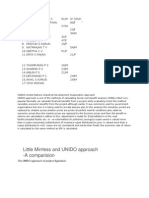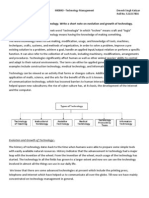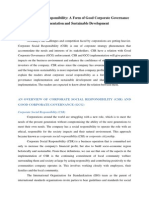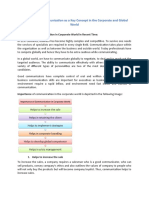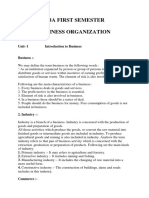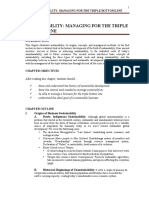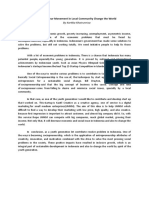Lecture Notes Chapter 7
Lecture Notes Chapter 7
Uploaded by
Gontzi MarinusCopyright:
Available Formats
Lecture Notes Chapter 7
Lecture Notes Chapter 7
Uploaded by
Gontzi MarinusOriginal Description:
Copyright
Available Formats
Share this document
Did you find this document useful?
Is this content inappropriate?
Copyright:
Available Formats
Lecture Notes Chapter 7
Lecture Notes Chapter 7
Uploaded by
Gontzi MarinusCopyright:
Available Formats
ENTREPRENEURSHIP: VALUE ADDED VENTURES
CHAPTER 7
ENTREPRENEURSHIP: VALUE ADDED
VENTURES
INTRODUCTION
This chapter outlines approaches to social entrepreneurship by grounding its argument in Polanyis
three economic systems. As these interact in accordance with prevailing socio-political systems, we
link them to arguments for different schools of social entrepreneurship. By examining their
socio-economic origins, a deeper understanding of internal and external social value creation can
be presented. We identify early developments that frame social entrepreneurship with reference to
social innovation, social purpose, and socialization. As the chapter develops, an argument is made
for a hybridization perspective that more closely reflects practice.
In the remaining sections of the chapter, we explore how responsible management practices can be
grounded in the challenges associated with a given starting point. We examine three journeys: 1)
from Third Sector to Social Economy; 2) from Private to Social Economy, and; 3) from Public
Service to Social Entrepreneurship. Each initiating context requires a responsible manager to identify
bodies of knowledge that inform the development of new skill sets. The journey from Third Sector to
Social Economy requires a shift from the mindset of philanthropy (helping only others) to mutuality
(helping self and others). Outlining a pathway from Private to Social Economy requires a shift from
profit-maximizing for shareholders to wealth-maximizing for stakeholders. Lastly, the transition
from public servant to social entrepreneur requires a new capacity to select and commission nonprofit, public-private, or mutual/co-operative solutions to satisfy public policy.
CHAPTER OBJECTIVES
After reading this chapter, students should be able to
. . . analyze an organizations relationship to the social economy.
. . . select social entrepreneurial strategies.
. . . create value-added ventures.
CHAPTER OUTLINE
Opening Case: Mondragon Co-operatives: This case provides a living example of the way
social innovation, social purposes and socialized ownership and control can give rise to an enduring
value-added venture:
Social innovation: identifying the heroes behind social change in institutions
Social purpose and mission: identifying social objectives and creating social
transformation.
Socialized ownership and control: identifying how mutuality and co-operation can
turn individual initiatives into coordinated collective actions.
ENTREPRENEURSHIP: VALUE ADDED VENTURES
I.
Social Entrepreneurship and Responsible Management: In this chapter, we
clarify issues by problematizing three dominant schools of social entrepreneurial thought. We
argue that a more useful perspective is to examine the socioeconomic origins of different schools to
identify the challenges that arise when responsible managers pursue socio-entrepreneurial goals from
different starting points.
II.
Goal: The Value-Added Venture: The goal of social entrepreneurship as we describe
it in this chapter is a value-added venture. A venture is an undertaking that involves uncertainty and
the pursuit of reward or opportunity. The term value-added here refers to social-value added, often
through the solution or mitigation of a social issue. In the case of social entrepreneurship, such social
value can be added either through the socialization of the organization, or through an external social
mission that, when fulfilled, benefits society, often transforming the society and its systems.
III.
B.
follows:
Phase 1: Understanding Social Entrepreneurship and Social Innovation
A.
Elementary Perspectives of Social Entrepreneurship: To understand
social entrepreneurship and the related social innovation process, we illustrate the following
three elementary perspectives of social entrepreneurship:
Social innovation
Social purposes (leading to social impact and transformation)
Socialized ownership and control
Economic Systems: Polanyi offered a critique of economic exchange systems, outlining as
Communal system operates on a large scale, based on mutuality and reciprocity
Redistribution systems pooling produce for reciprocal exchange and to ensure
provision for public events and economic uncertainty
Production for markets the notions of gain, profit, and loss become more
important
C.
Identifying the Starting Point for Social Innovation: Before we examine
the challenges encountered during the pursuit of social entrepreneurship, it is worth setting
out a theoretical framework to guide discussion. We start by linking Polanyis concept of
reciprocity to Pearces model of a third system (see Figure 7.2). Charting a social entrepreneurial path requires a reflexive awareness of the way economic thought orients a managers
decision-making. Three schools of social entrepreneurship reflect interactions between three
economic systems.
First system: Private for-profit oriented micro-businesses, SMEs, large
businesses, multi-national corporations.
Second system: Public planned provision community councils, local authorities,
national/regional governments, European Union, United Nations.
Third system: Social family, voluntary organizations and social enterprises clubs/
community enterprises, social firms, social businesses/charities, mutuals, fair trade
companies, worker co-operatives.
D.
Implications for Social Entrepreneurship: By linking Polanyis work on
economic systems to Pearces theory of social enterprise, we gradually build up the
argument for a hybridization approach to the topic.
Building on acceptance that hybridization of economic systems can occur, it follows that
social entrepreneurship can occur both inside and outside the third sector. We argue that the
areas between the third and public sectors, between the public and private sectors, and
between the third and private sector catalyze social entrepreneurship.
E.
Money, Labor, and Land: Polanyi does not argue against market logic in its
entirety, only against the commoditization of fictitious goods. Money, labor, and land, he
ENTREPRENEURSHIP: VALUE ADDED VENTURES
asserts, cannot be treated as commodities. If they are, each will be degraded and their value
destroyed or distorted.
Real and Fictitious Goods: introduces the difference between householding,
production for market and identifies fictitious goods.
Four approaches to social entrepreneurship: identifies non-profit, CSR, more-thanprofit and multi-stakeholder approaches to social entrepreneurship.
Types of Hybridisation: the synthesis of different exchange systems.
A multistakeholder model based on social economy principles is put forward as a socially
rational approach to integrating economic systems. In this model, there are a number of
variants where integration of different systems of exchange is partial rather than complete:
A. Nonprofit: Redistribution and Reciprocity
B. Corporate Social Responsibility: Redistribution and Market
C. More-than-Profit: Reciprocity and Market
D. Multistakeholder (Social Economy): Reciprocity, Redistribution, and Market
III.
Phase 2: Envision Your Pathway
A.
From Third Sector to Social Economy: In the following bullet points,
challenges in the transition to social economy are identified along with macro-economic
considerations.
How do you know you are in the Third Sector: This topic identifies language cues
associated with philanthropy and mutuality.
Cultural Influences on Income Streams: Different cultural attitudes to trading and
government support.
Classifying Activities: Wei-Skillerns matrix for deciding between different project
activities.
Steps to achieve change: Skill sets for non-profit (Type A); more-than-profit (Type
B) and social economy (Type D) enterprise development.
B.
From Private to Social Economy: The mindset of the market and its
limitations. The difference between production for members (householding) and
production for market leads into a series of clarifying examples.
Barcelona FC v Arsenal FC: are you member-led or investor-led?
Challenges and opportunities: differences and tensions between manager and
member power: step changes in the transition to social economy.
From employee to co-operative ownership: how Mondragon co-operatives make the
transition.
Steps to achieve change: Skills sets for Type A, B and D social enterprise development.
C.
From Public Service to Social Entrepreneurship: The influence of New
Public Management (NPM) as a theory of public sector transformation is outlined. By
considering the difference between privatization and localization we contextualise how
NPM might trigger a range of changes in the delivery health and public services.
The loss of public sector distinctiveness: NPM doctrines that erode professional
judgment in favor of accountability of (and to) managers.
From bureaucratic rules to management discretion: NPM doctrines that encourage
top management control of targets and performance management.
Contrasting Cases: the case of Eaga plc v Italian social co-ops.
Steps to achieve change: Skills sets for Type B, C and D social enterprise
development
ENTREPRENEURSHIP: VALUE ADDED VENTURES
PRINCIPLES OF MANAGEMENT: ENTREPRENEURSHIP
I.
II.
III.
IV.
V.
VI.
VII.
Social entrepreneurship describes the discovery and sustainable exploitation of opportunities to create social and environmental benefits.
The goal of the social entrepreneurship process is to create a value-added venture that at the
same time socializes the organization internally and creates social value systemically externally.
The market is only one type of economic system. There are alternatives.
The nonprofit model of social entrepreneurship emphasizes reciprocity and redistribution
facilitated by voluntary and political action.
The corporate social responsibility model of social entrepreneurship emphasizes redistribution through new types of market exchange.
The more-than-profit model of social entrepreneurship emphasizes market exchanges that
encourage reciprocity.
The social economy model of social entrepreneurship emphasizes the hybridization of reciprocity, redistribution, and market exchange to maximize human well-being.
You might also like
- Solution Manual For Management Leading Collaborating in A Competitive World 14th Edition Thomas Bateman Robert KonopaskeDocument30 pagesSolution Manual For Management Leading Collaborating in A Competitive World 14th Edition Thomas Bateman Robert KonopaskeDonaldKnoxorzm100% (41)
- Index Astartes IVDocument68 pagesIndex Astartes IVGontzi Marinus89% (9)
- Little Mirrless and UNIDO Approach - A ComparisionDocument10 pagesLittle Mirrless and UNIDO Approach - A ComparisionThirumanas Kottarathil K RNoch keine Bewertungen
- Dfi 303 Ext 416Document8 pagesDfi 303 Ext 416Kelvin OrongeNoch keine Bewertungen
- HRD 2401 Entrepreneurship SkillsDocument2 pagesHRD 2401 Entrepreneurship SkillsFRANCISCA AKOTHNoch keine Bewertungen
- Systematic Review On Sustainable Entrepreneurship Education (SEE) : A Framework and AnalysisDocument24 pagesSystematic Review On Sustainable Entrepreneurship Education (SEE) : A Framework and AnalysisVatsal Shah100% (1)
- Role of An EntrepreneurDocument11 pagesRole of An EntrepreneurSantosh Adhikari100% (1)
- Industrial ManagementDocument10 pagesIndustrial ManagementHimanshu GautamNoch keine Bewertungen
- MI0040 - Technology Management - 521157856Document9 pagesMI0040 - Technology Management - 521157856Devesh SinghNoch keine Bewertungen
- Introduction To Business EthicsDocument18 pagesIntroduction To Business EthicsKaivalya Purushottam MawaleNoch keine Bewertungen
- Corporate Social ResponsibilityDocument9 pagesCorporate Social ResponsibilityAmalia Desti ArthaningtyasNoch keine Bewertungen
- Hildana TadesseDocument56 pagesHildana TadesseAschenaki MebreNoch keine Bewertungen
- Emergence of Communication As A Key Concept in The Corporate and Global WorldDocument3 pagesEmergence of Communication As A Key Concept in The Corporate and Global WorldVaibhavNoch keine Bewertungen
- Production FunctionDocument8 pagesProduction FunctionViraja GuruNoch keine Bewertungen
- Organisation Development 1Document10 pagesOrganisation Development 1Su_NeilNoch keine Bewertungen
- Dalberg Case Study CompetitionDocument2 pagesDalberg Case Study CompetitionDuttatreya DasNoch keine Bewertungen
- Business Organisation BBA IST SEMDocument20 pagesBusiness Organisation BBA IST SEMSaurabh1531987Noch keine Bewertungen
- AAE 3106. Organization Theory 2023Document161 pagesAAE 3106. Organization Theory 2023Marc Ice creamNoch keine Bewertungen
- Financial Management: Operating Leverage & Financial LeverageDocument70 pagesFinancial Management: Operating Leverage & Financial LeverageHarnitNoch keine Bewertungen
- Economy of RajasthanDocument12 pagesEconomy of RajasthanNaruChoudharyNoch keine Bewertungen
- Managerial Econonics: AssignmentDocument4 pagesManagerial Econonics: AssignmentVincent DanielNoch keine Bewertungen
- Engineering Economics and Financial AccountingDocument5 pagesEngineering Economics and Financial AccountingAkvijayNoch keine Bewertungen
- Employee Empowerment and Interpersonal Interventions: An Experiential Approach To Organization Development 8 EditionDocument69 pagesEmployee Empowerment and Interpersonal Interventions: An Experiential Approach To Organization Development 8 EditionjocaNoch keine Bewertungen
- Types of Social EntrepreneurshipDocument1 pageTypes of Social EntrepreneurshipManahil AsimNoch keine Bewertungen
- BECSRDocument35 pagesBECSRProf. Bhaktabandhu Dash100% (1)
- Business Management by Juraz 85712Document53 pagesBusiness Management by Juraz 85712Munavvir PNoch keine Bewertungen
- Capacity Planning Unit 9Document5 pagesCapacity Planning Unit 9Benjamin Adelwini BugriNoch keine Bewertungen
- Ch3 - Small Business and Corporate Enterpreneurship PDFDocument67 pagesCh3 - Small Business and Corporate Enterpreneurship PDFdanial001100% (1)
- What Is A Project?: Project Management Mrs - Asmar MDocument5 pagesWhat Is A Project?: Project Management Mrs - Asmar MHuda BasimNoch keine Bewertungen
- Industrial ManagementDocument6 pagesIndustrial ManagementFarhan AriyanNoch keine Bewertungen
- Business EthicsDocument27 pagesBusiness EthicsSee_star99100% (1)
- Chapter 1 Scientific ArticleDocument24 pagesChapter 1 Scientific Articleprasetyoeko19889Noch keine Bewertungen
- Affordable and Clean EnergyDocument6 pagesAffordable and Clean EnergyZaraNoch keine Bewertungen
- UT Dallas Syllabus For Pa6326.501.09f Taught by (jlh085000)Document13 pagesUT Dallas Syllabus For Pa6326.501.09f Taught by (jlh085000)UT Dallas Provost's Technology GroupNoch keine Bewertungen
- ENF123 Lecture 1Document11 pagesENF123 Lecture 1Dave NNoch keine Bewertungen
- Corporate Governance of P&G IndiaDocument8 pagesCorporate Governance of P&G IndiaKuntalDekaBaruahNoch keine Bewertungen
- Chapter 1: Exploring The World of Business and EconomicsDocument7 pagesChapter 1: Exploring The World of Business and EconomicsDaniel WidjojoNoch keine Bewertungen
- Linear Programming Problems-Simplex Method PDFDocument53 pagesLinear Programming Problems-Simplex Method PDFsrutadiptaNoch keine Bewertungen
- All in One Teaching Material Industrial Management and EngineeringDocument120 pagesAll in One Teaching Material Industrial Management and EngineeringBelete Lngerew100% (2)
- PESTLE - Macro Environmental AnalysisDocument4 pagesPESTLE - Macro Environmental AnalysisMyat Zar GyiNoch keine Bewertungen
- Catanduanes State University: Republic of The Philippines Virac, CatanduanesDocument5 pagesCatanduanes State University: Republic of The Philippines Virac, CatanduanesMichelle Go100% (1)
- Entrepreneurship Development and Project ManagementDocument20 pagesEntrepreneurship Development and Project Managementpavan1235100% (1)
- Envh and EcologyDocument410 pagesEnvh and EcologyErega AyeleNoch keine Bewertungen
- Assignment 1 Scop of Chemical Enginnerening in EhiopiaDocument5 pagesAssignment 1 Scop of Chemical Enginnerening in Ehiopiafekremariam AmbawNoch keine Bewertungen
- Environmental Health: Prepared by Suhail Al HuDocument35 pagesEnvironmental Health: Prepared by Suhail Al HuDama MoralloNoch keine Bewertungen
- Introduction To EconomyDocument2 pagesIntroduction To Economyjasim ansariNoch keine Bewertungen
- Individual Assignment On Chapter Seven & Eight-OBDocument10 pagesIndividual Assignment On Chapter Seven & Eight-OBDawit AsmelashNoch keine Bewertungen
- Chapter 5 - Composting Process and TechniquesDocument3 pagesChapter 5 - Composting Process and TechniquesCatherineBermudezTugNoch keine Bewertungen
- Unit 4 Project Management 4Document13 pagesUnit 4 Project Management 4chuchuNoch keine Bewertungen
- Aicte SchemesDocument39 pagesAicte SchemesAnonymous WtjVcZCgNoch keine Bewertungen
- Bit 2318 Information System AuditDocument7 pagesBit 2318 Information System AuditWaguma Leticia100% (1)
- Entrepreneurial Project DevelopmentDocument23 pagesEntrepreneurial Project DevelopmentVrishal GovaleNoch keine Bewertungen
- Change ManagementDocument84 pagesChange Managementmelkambekele541100% (1)
- Power & Politics ReadonlyDocument20 pagesPower & Politics ReadonlyAnkkit Raj SrivastavaNoch keine Bewertungen
- Assignment Semester 4 BduDocument4 pagesAssignment Semester 4 Bdusagar0290% (1)
- IB Business Management Section 1.2 NotesDocument4 pagesIB Business Management Section 1.2 NotesAli Al-KhalilNoch keine Bewertungen
- Business Ethics in IndiaDocument3 pagesBusiness Ethics in Indianikhu_shuklaNoch keine Bewertungen
- LT 1. Change ManagementDocument71 pagesLT 1. Change Managementፀፀፀፀፀ ከፀፀዘከNoch keine Bewertungen
- Tech To Go Day1Document52 pagesTech To Go Day1monkeybike880% (5)
- Introduction To PlanningDocument11 pagesIntroduction To PlanningM.h. SamratNoch keine Bewertungen
- Conflict and Diversity ManagementDocument25 pagesConflict and Diversity ManagementUb UsoroNoch keine Bewertungen
- Data Collection Instruments For Info Ecology Study :DDocument13 pagesData Collection Instruments For Info Ecology Study :DRofren BaldoveNoch keine Bewertungen
- The Four Walls: Live Like the Wind, Free, Without HindrancesFrom EverandThe Four Walls: Live Like the Wind, Free, Without HindrancesRating: 5 out of 5 stars5/5 (1)
- Lecture Notes Chapter 6Document4 pagesLecture Notes Chapter 6Gontzi MarinusNoch keine Bewertungen
- Lecture Notes Chapter 5Document4 pagesLecture Notes Chapter 5Gontzi MarinusNoch keine Bewertungen
- Lecture Notes Chapter 1Document4 pagesLecture Notes Chapter 1Gontzi MarinusNoch keine Bewertungen
- Lecture Notes Chapter 5Document4 pagesLecture Notes Chapter 5Gontzi MarinusNoch keine Bewertungen
- Lecture Notes Chapter 4Document4 pagesLecture Notes Chapter 4Gontzi MarinusNoch keine Bewertungen
- Income Redistribution: ©2016 by Mcgraw-Hill Education LimitedDocument24 pagesIncome Redistribution: ©2016 by Mcgraw-Hill Education LimitedGontzi MarinusNoch keine Bewertungen
- Lecture Notes Chapter 3Document5 pagesLecture Notes Chapter 3Gontzi Marinus100% (1)
- ECO350 18 OctDocument11 pagesECO350 18 OctGontzi MarinusNoch keine Bewertungen
- Factors For The Success OFA Project: What Makes A Project Succeed or Fail?Document7 pagesFactors For The Success OFA Project: What Makes A Project Succeed or Fail?Gontzi MarinusNoch keine Bewertungen
- LoadOrder - Skyrim - 2016 11 02T22 57 39Document2 pagesLoadOrder - Skyrim - 2016 11 02T22 57 39Gontzi MarinusNoch keine Bewertungen
- Fire Emblem 7 CodesDocument2 pagesFire Emblem 7 CodesGontzi MarinusNoch keine Bewertungen
- How Sociopreneur Movement in Local Community Change The WorldDocument3 pagesHow Sociopreneur Movement in Local Community Change The WorldKartika AfrizalNoch keine Bewertungen
- Entrepreneurship MCQ SetDocument25 pagesEntrepreneurship MCQ SetNitin Bhardwaj100% (1)
- S.N. Answer Option 1 Option 2 Option 3 Option 4Document6 pagesS.N. Answer Option 1 Option 2 Option 3 Option 4ritz meshNoch keine Bewertungen
- Business Ethics and Social EntrepreneurshipDocument45 pagesBusiness Ethics and Social EntrepreneurshipLeo Casaclang100% (1)
- Module 5 SOCIAL ENTREPRENEURSHIPDocument60 pagesModule 5 SOCIAL ENTREPRENEURSHIPMamatha NUNoch keine Bewertungen
- Final IdpDocument7 pagesFinal IdpNihalAgarwalNoch keine Bewertungen
- Youth Entrepreneurship in Eastern Partnership Countries The Way ForwardDocument44 pagesYouth Entrepreneurship in Eastern Partnership Countries The Way ForwardEaP CSFNoch keine Bewertungen
- Social Entrepreneurship - Implications For Management PracticeDocument8 pagesSocial Entrepreneurship - Implications For Management Practicenihal zidanNoch keine Bewertungen
- PRINCIPLES OF MANAGEMENT IIB ENTREPRENEURSHIP Chapter 15Document3 pagesPRINCIPLES OF MANAGEMENT IIB ENTREPRENEURSHIP Chapter 15Liora MichaelsNoch keine Bewertungen
- The Penta Helix Model of Innovation in Oman: An Hei PerspectiveDocument16 pagesThe Penta Helix Model of Innovation in Oman: An Hei PerspectiveAlrence SantiagoNoch keine Bewertungen
- Enterprenership Individual AssignmentDocument13 pagesEnterprenership Individual AssignmentYgeremu SisayNoch keine Bewertungen
- Entrepreneurship ManagementDocument94 pagesEntrepreneurship ManagementHarshad PawarNoch keine Bewertungen
- Ashoka Fellow Welcome PacketDocument19 pagesAshoka Fellow Welcome PacketAshoka: Innovators for the PublicNoch keine Bewertungen
- ICON College of Technology and Management Faculty of Business and Management StudiesDocument26 pagesICON College of Technology and Management Faculty of Business and Management Studiesasifabdullah khanNoch keine Bewertungen
- Module 3Document12 pagesModule 3Christian Luis De GuzmanNoch keine Bewertungen
- Chapter 3Document8 pagesChapter 3Sanya rajNoch keine Bewertungen
- MBA 501 14th June 2021Document12 pagesMBA 501 14th June 2021Edward EkakaNoch keine Bewertungen
- Glossary - 257 258 - Entrepreneurship DevelopmentDocument4 pagesGlossary - 257 258 - Entrepreneurship DevelopmentrajendrakumarNoch keine Bewertungen
- Transformative Entrepreneurship in Post-War Contexts Systematic Review - Faten Kanaan - BGLP0010 LectureDocument47 pagesTransformative Entrepreneurship in Post-War Contexts Systematic Review - Faten Kanaan - BGLP0010 LectureFempower MéxicoNoch keine Bewertungen
- Nonprofit TitlesDocument4 pagesNonprofit Titlessuhair1951Noch keine Bewertungen
- A Tale of Two Cultures-Charity-Problem Solving-And The Future of Social EntrepreneurshipDocument19 pagesA Tale of Two Cultures-Charity-Problem Solving-And The Future of Social EntrepreneurshipMashumi SankheNoch keine Bewertungen
- Social Entrepreneurship - Creating New Business Models To Serve The Poor PDFDocument6 pagesSocial Entrepreneurship - Creating New Business Models To Serve The Poor PDFariffaridaNoch keine Bewertungen
- Ronna Mae A. DungogDocument3 pagesRonna Mae A. DungogRonna Mae DungogNoch keine Bewertungen
- Nick Perlas - Bayanihan EconomicsDocument37 pagesNick Perlas - Bayanihan EconomicsJDNoch keine Bewertungen
- PME Unit 5 - NotesDocument19 pagesPME Unit 5 - NotesRakoon DogNoch keine Bewertungen
- Business Orientation Project 2022-24Document8 pagesBusiness Orientation Project 2022-24Mr. Shahil Kumar Student, Jaipuria LucknowNoch keine Bewertungen
- Entrepreneurship in Rural Hospitality and Tourism. A Systematic Literature Review of Past Achievements and Future PromisesDocument38 pagesEntrepreneurship in Rural Hospitality and Tourism. A Systematic Literature Review of Past Achievements and Future PromisesÑda JalalNoch keine Bewertungen
- Vocation of A Business Leader ReflectionDocument1 pageVocation of A Business Leader ReflectioncharlynbelleNoch keine Bewertungen


